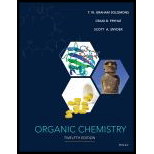
Concept explainers
Interpretation:
The Kiliani–Fischer reaction for the synthesis of epimeric aldoses is to be outlined and Fischer projection of
Concept introduction:
舧 A carbohydrate is a
舧
舧 Carbohydrates are oxidized by
舧 Aldaric acids are carbohydrates having two

舧 The molecules that are nonsuperimposable or not identical with their mirror images are known as chiral molecules.
舧 A pair of two mirror images that are nonidentical is known as enantiomers, which are optically active.
舧 The stereoisomers that are nonsuperimposable on each other and not mirror images of each other are known as diastereomers.
舧 The achiral compounds in which plane of symmetry is present internally and consists of chiral centres are known as meso compounds, but they are optically inactive.
舧 Compounds that have a plane of symmetry tend to exist in meso forms. A meso form arises when the two stereoisomers produce superimposable images, and hence, compounds having meso forms are optically inactive.
舧 The Kiliani-Fischer reaction is used for increasing the number of carbon atoms of the respective aldoses, thereby, lengthening the carbon chain of the compound. It is an effective and economic process for synthesizing monosaccharides through the hydrolysis of a cyanohydrin. Thus, it lengthens the carbon chain of the aldose by one carbon atom. It is used to produce epimers of higher aldoses from a lower aldose, that is, a single aldose produces a mixture of two diastereomeric sugars called epimers.
Want to see the full answer?
Check out a sample textbook solution
Chapter 22 Solutions
EBK ORGANIC CHEMISTRY
- b) Disaccharide E is a reducing sugar. It is hydrolyzed by an α-glycosidase enzyme, which means it contains an α- glycoside link. Treatment of E with Ag2O and excess MeDgives an octamethyl derivative F. Hydrolysis of F in dilute aqueous acid gives the pair of molecules shown below. Write the structures of E and F. (If the stereochemistry at a particular carbon is not determined by the above data, indicate this with a wavy line as shown below.) HO OMe OMe MeO MeO OH OMe Am OH OMe OMearrow_forwardWhat is the product of the starting material D-glyceraldehyde which will (1) produce aldaric acid upon reacting with HNO3 + H2O, NaOCH2, NH2OH, and (CH3CO)2O + NaOCOCH3 (2) produce tartaric acid upon reacting with HNO3 + H2O, NaOCH3, NH2OH, and (CH3CO)2O + NaOCOCH3arrow_forwardWhat is the product (from the image below) of the starting material D-glyceraldehyde which will (1) produce aldaric acid upon reacting with HNO3 + H2O, NaOCH2, NH2OH, and (CH3CO)2O + NaOCOCH3 (2) produce tartaric acid upon reacting with HNO3 + H2O, NaOCH3, NH2OH, and (CH3CO)2O + NaOCOCH3arrow_forward
- Emil Fischer synthesized l-gulose, an unusual aldohexose that reduces to give d-glucitol.Suggest a structure for this l sugar, and show how l-gulose gives the same alditol asd-glucose. (Hint: d-Glucitol has ¬CH2OH groups at both ends. Either of these primaryalcohol groups might have come from reduction of an aldehyde.)arrow_forward3a. 3b. 3c 3d. 3e. CO₂ clavulanic acid CH₂-OH H Answer the following questions about clavulanic acid. Does clavulanic acid inhibit D-alanyl-D-alanine transpeptidase? Does clavulanic acid contain a ß-lactam? Does clavulanic acid contain a thiazolium ring? What is the result of the treatment of penicillinase with clavulanic acid? Does clavulanic acid form a covalent acyl-enzyme intermediate with penicillinase?arrow_forward(b) a-d-talopyranose + excess dimethyl sulfatearrow_forward
- 4arrow_forwardBelow are drawn the different chair conformations of the methyl glycoside of galactose. но он но он оМе OMe но- в A OH он (ii) Give the correct full name of compound A (= B) (ii) The name of the compound does not contain information on conformation (only configuration). Give the accepted conformational description for compound A and for compound B. (iv) Draw the Fischer projections of the open form of the corresponding reducing sugars of compound A (= B).arrow_forwardPredict the reactions ofcarbohydrates in acidic and basicsolutions, and with oxidizingand reducing agentsarrow_forward
- Assume that for your Biochemistry practical, you were asked to synthesise D-Galactose. You went to chemical storage room to take some D-lyxose to use as the starting material. But there you found that labels had fallen off from the bottles containing D-lyxose and D-xylose. How could you determine which bottle contains D- lyxose?arrow_forwardWhen the gum of the shrub Sterculia setigera is subjected to acidic hydrolysis, one of the water-soluble components of thehydrolysate is found to be tagatose. The following information is known about tagatose:(1) Molecular formula C6H12O6(2) Undergoes mutarotation.(3) Does not react with bromine water.(4) Reduces Tollens reagent to give d-galactonic acid and d-talonic acid.(5) Methylation of tagatose (using excess CH3 I and Ag2O) followed by acidic hydrolysis gives1,3,4,5-tetra-O-methyltagatose.(a) Draw a Fischer projection structure for the open-chain form of tagatose.(b) Draw the most stable conformation of the most stable cyclic hemiacetal form of tagatosearrow_forwardKindly answer question f,g,harrow_forward
 Organic ChemistryChemistryISBN:9781305580350Author:William H. Brown, Brent L. Iverson, Eric Anslyn, Christopher S. FootePublisher:Cengage Learning
Organic ChemistryChemistryISBN:9781305580350Author:William H. Brown, Brent L. Iverson, Eric Anslyn, Christopher S. FootePublisher:Cengage Learning
 Macroscale and Microscale Organic ExperimentsChemistryISBN:9781305577190Author:Kenneth L. Williamson, Katherine M. MastersPublisher:Brooks Cole
Macroscale and Microscale Organic ExperimentsChemistryISBN:9781305577190Author:Kenneth L. Williamson, Katherine M. MastersPublisher:Brooks Cole EBK A SMALL SCALE APPROACH TO ORGANIC LChemistryISBN:9781305446021Author:LampmanPublisher:CENGAGE LEARNING - CONSIGNMENT
EBK A SMALL SCALE APPROACH TO ORGANIC LChemistryISBN:9781305446021Author:LampmanPublisher:CENGAGE LEARNING - CONSIGNMENT



